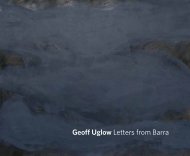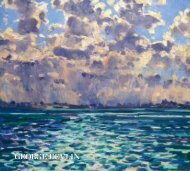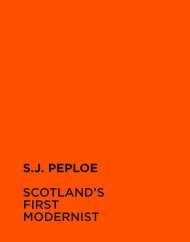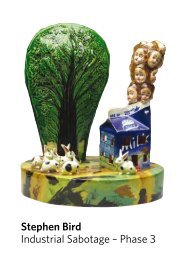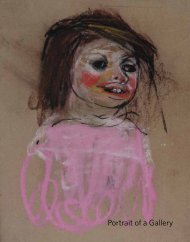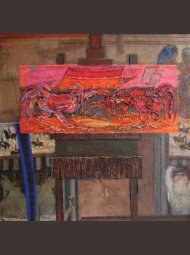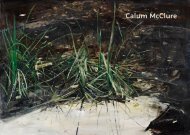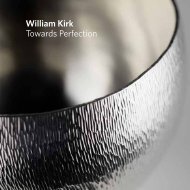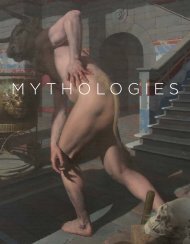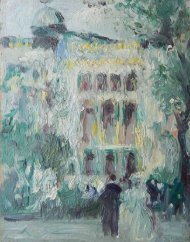Download a PDF of the exhibition catalogue - The Scottish Gallery
Download a PDF of the exhibition catalogue - The Scottish Gallery
Download a PDF of the exhibition catalogue - The Scottish Gallery
Create successful ePaper yourself
Turn your PDF publications into a flip-book with our unique Google optimized e-Paper software.
Blyth’s conversion was certainly complete and in 1928 for <strong>the</strong> ‘Second<br />
Inaugural Exhibition’ organised at <strong>the</strong> Kirkcaldy Art <strong>Gallery</strong> it was<br />
decided to devote one room <strong>of</strong> 25 pictures to Peploe. Stanley Cursiter,<br />
in his biography <strong>of</strong> <strong>the</strong> artist, states that this was ‘in a large measure due<br />
to <strong>the</strong> convener J.W. Blyth and ano<strong>the</strong>r member <strong>of</strong> <strong>the</strong> committee Mr R.<br />
Wemyss Honeyman’. <strong>The</strong> reviews <strong>of</strong> <strong>the</strong> <strong>exhibition</strong> were good, especially<br />
for Peploe.<br />
However, apart from two Iona landscapes and a still-life, Blyth bought very few<br />
pictures between 1926 and 1933 because <strong>of</strong> <strong>the</strong> Depression; if business had been better<br />
(or indeed prices at that time lower) he would undoubtedly have bought more, earlier.<br />
<strong>The</strong> pictures collected by Blyth up to his last purchase in 1956 show Peploe’s range in<br />
still-life, landscapes, seascapes and a few figure subjects. He had ample opportunity to<br />
fill in gaps from <strong>the</strong> periods before he began his purchases <strong>of</strong> new work, particularly<br />
from <strong>the</strong> dealers’ inventories after <strong>the</strong> painter’s early death in 1935. This said, he lent<br />
pictures for <strong>The</strong> <strong>Scottish</strong> <strong>Gallery</strong>’s 1936 Peploe Memorial Exhibition and contributed<br />
an introduction to its <strong>catalogue</strong>, and it is clear from a letter <strong>of</strong> gratitude written to him<br />
by <strong>the</strong> painter’s widow shortly afterwards that he was already recognised as a significant<br />
collector <strong>of</strong> Peploe’s best work long before <strong>the</strong> artist’s death. Her letter refers to a rare<br />
visit made to see <strong>the</strong> Blyths at Wilby House, and is testament to <strong>the</strong> Peploes’ appreciation<br />
<strong>of</strong> <strong>the</strong> support Blyth’s patronage provided.<br />
An early picture, A Street in Comrie <strong>of</strong> 1902, purchased by Blyth during <strong>the</strong> 1920s,<br />
is a good example <strong>of</strong> <strong>the</strong> influence <strong>of</strong> French Impressionism and Sisley in particular.<br />
<strong>The</strong> Lobster was bought in May 1937 and is a pre-eminent example <strong>of</strong> his early style.<br />
However, <strong>the</strong> period that dominates <strong>the</strong> works by Peploe in Blyth’s collection is <strong>the</strong> last<br />
phase, 1920–35. Once again it is not far-fetched to see in Peploe’s mature work a musical<br />
parallel which would have appealed to Blyth on both an intellectual and emotional level.<br />
In March 1941, in his introduction to <strong>the</strong> <strong>catalogue</strong> for a Peploe restrospective at <strong>the</strong><br />
National <strong>Gallery</strong> <strong>of</strong> Scotland, Stanley Cursiter wrote:<br />
His concentration on still-life arose from <strong>the</strong> desire to have complete<br />
control over conditions and circumstances. He could plan <strong>the</strong> limits <strong>of</strong> his<br />
colour scheme and devise intermediate notes; <strong>the</strong> intensity and direction<br />
<strong>of</strong> light; <strong>the</strong> form and pattern <strong>of</strong> his group. In this way Peploe’s work<br />
became a form <strong>of</strong> visual music in which every note <strong>of</strong> colour took its<br />
place in a melodic scheme, to which <strong>the</strong> setting or background presented<br />
<strong>the</strong> harmony and <strong>the</strong> design pattern stated <strong>the</strong> tempo.<br />
Blyth did not purchase a work by one <strong>of</strong> <strong>the</strong> three o<strong>the</strong>r <strong>Scottish</strong> Colourists until<br />
1939. In total he collected only 11 works by <strong>the</strong>se artists including <strong>the</strong> beautiful Paris-<br />
Plage street scene (page 71) which, though on <strong>the</strong> small-panel pochard scale, is a key work<br />
in J.D. Fergusson’s journey into modernism.<br />
Blyth acquired two works by English painter Philip Wilson Steer (1860–1942)<br />
in 1934: Farm at Long Crendon and Sandy Road. Both were purchased from <strong>the</strong> Barbizon<br />
House, run by <strong>the</strong> influential <strong>Scottish</strong> dealer David Croal Thomson in London. <strong>The</strong>se<br />
are <strong>the</strong> only two major works bought before 1939 which are not by a <strong>Scottish</strong> artist.<br />
In his later biography <strong>of</strong> Steer, D.S. MacColl would link McTaggart to Steer as modern<br />
successors to Constable.<br />
During 1939 and 1940 Blyth spent a lot <strong>of</strong> time in London and certainly visited<br />
Reid & Lefèvre, who continued to represent <strong>the</strong> Peploe estate and where Peploe’s older<br />
13



